Preview: Dragon Age 2 - Origins through Mass Effect specs
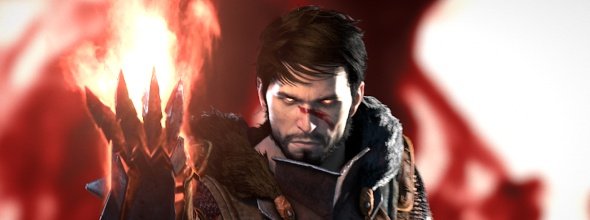
I'm sitting in a dark room on the third floor of BioWare's Edmonton offices, and everything has changed. PC Gamer loved Dragon Age, slapping a 94% score on it and proclaiming it the best RPG of the decade. No developer could be blamed for simply jamming the existing framework with more quests and calling it a sequel. But BioWare aren't doing that.
Dragon Age 2 is a tectonic shift in approach, a game that has actively learned from feedback, from criticism, and from the techniques of the studio's mega-selling stablemates. This is Dragon Age fundamentally altered and upgraded, with three core areas – dialogue, combat and visuals – comprehensively gutted and redressed by its Canadian developers.
The game's sharpened and tightened look demonstrates the team's commitment to the revamp: BioWare are aiming for visuals that truly represent Dragon Age's violent world. Stark, clean lines dominate, high contrast environs as the counterpoint to spiky, angular enemies. It's a galaxy away from Origins' muddy browns and indistinct texturing.
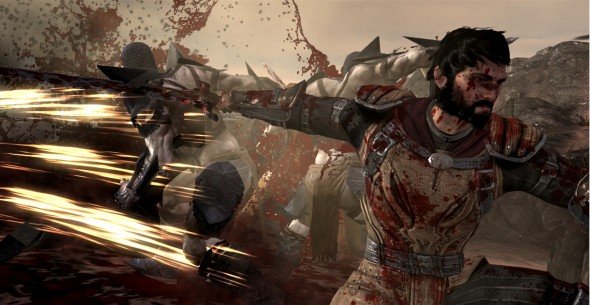
An upgraded, lightning-fast combat engine drives home the changes. The player character – going by the name of Hawk and referred to as 'Champion of Kirkwall' – moves faster than anything in the first Dragon Age, his attacks thunking into flesh with visceral force. BioWare's mantra is 'when I press something, awesome happens'. It's proven as I witness the sword-wielding player-hero flitting between mano-amano scuffles. Special abilities are deployed liberally, twatting hurlocks and genlocks in the air, into the ground, rending bone and flesh exactly as you'd expect an angry man with a humongous sword would.
Nothing highlights Dragon Age 2's refocus as much as the moment the Champion turns to his companion and starts to speak. Up pops a conversation wheel, peppered with choices of dialogue. Selecting one sets Hawk talking. Gritty of tone and fluffy of facial hair, he's an obvious badass in a way Origins' user-defined specimens could never be. This is Dragon Age as viewed through Mass Effect glasses, and Hawk is your Commander Shepard.
Speechless
These revelations are a genuine shock to me, sitting in that dark room. With the demonstration over and my brain overflowing with new information, I try to coalesce my questions into a coherent sequence to launch at the trio of developers who sit opposite me, grinning broadly. I fail.
“Speaking character! Wha-?!” I gibber at Mike Darreth, Dragon Age 2's executive producer. He smiles knowingly: “it was a long discussion.” The decision has been made, the game having been in development since March of 2009, but BioWare's development team still discuss the topic over burgers. “I told the Mass Effect team they were crazy for having player voiceover,” Mike confesses. “I'll happily admit I was wrong.”
The biggest gaming news, reviews and hardware deals
Keep up to date with the most important stories and the best deals, as picked by the PC Gamer team.
Mike explains the consequences of the team's decision: “it's a big change, it requires that the writing be done in a different way. In Origins, we had to write it out word for word.” For inspiration, they've looked two floors down in their Edmonton office, and incorporated a Mass Effect-style paraphrase system. “When you see the choices, you don't want to read something, and then have the protagonist just say it out loud. What Mass Effect did was to paraphrase it, which allows you to get the gist of what's going to happen.”
It's a proven system: dialogue gets unwieldy if you need to provide a menu with choices like 'stab the bad man then totally do sex on his girlfriend' displayed across half the screen. The new approach can simply replace that with 'dick move.'
A speaking protagonist also gives cutscenes much needed pep, as Mike outlines: “it's a more cinematic presentation. If you walk around the corner and there's a guy stapled to a board, you'll be like 'Oh my God, there's a guy stapled to a board!' Before, that had to come from the followers”
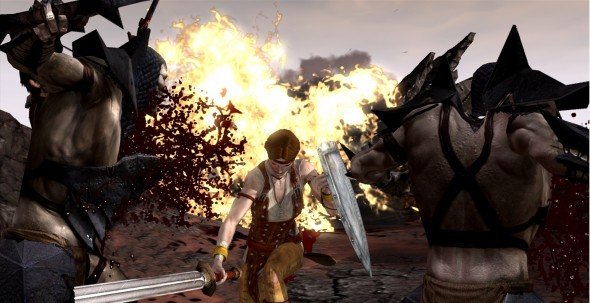
The first game's conversations were stilted, awkward things, obscuring the quality of the writing and the impact of the game's choices with stop-start vocal cues and a character perpetually staring into the middle distance. Matt Goldman, Dragon Age 2's art director, agrees: “you get everyone standing around waiting for your mute character to make a decision. If you just whipped out your murderknife, everyone has to stand there and look surprised for two minutes when you figure out what you're going to say next.”
Speedy reactivity is the goal. Skimreading single words gets players to the action quicker, while little symbols will indicate the intended result of each option. Faced with overwhelming Darkspawn odds in the demo I was shown, the Champion turned to his sisterly companion. Selecting the dialogue option decorated with a little sword, Champsy growled an aggressive challenge at the onrushing foes. Pick the comedy-mask option, however, and he'll take the piss, drawing an exasperated sigh from Bethany but lightening the mood.
Another icon occasionally pops up on the dialogue wheel, signifying specific actions open to your followers or your own character at that moment in the conversation. When a stream of Darkspawn is approaching, one of these pops up. Selecting it causes Bethany to launch a pre-emptive strike, squishing the forerunners with a fiery blast. Mike explains how these mid-chat abilities extend further than spellcasting: “if you had a staminabased skill like Shield Bash, we might have an option with a specific icon where you can smash faces with your shield. We want you to be making choices to determine your actions, and how you do things that cause you to take a stance, or to take an actual, physical action.”
Relax and rewind
Facts on the player-character are thin on the ground: you're stuck as a human, but Darreth confirms you'll be able to play as either a male or female. All that's locked down at the opening of the game are three simple constants: the Champion is a famous figure, he/ she has an unclear past, and the family name is Hawk. The rest is blank, ten years of history that you'll fill-in by playing the game. The choices you make across this decade will patch together to form the Champion of Kirkwall's legacy.
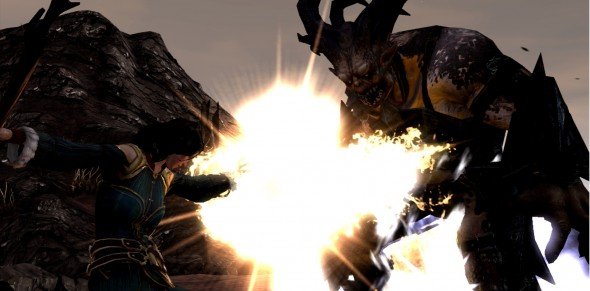
Dragon Age 2's lead designer and creative director, Mike Laidlaw, explains the theory behind the game's decade-long framed narrative: “Rather than 'there's an ancient evil that's awoken and you have to defeat it,' the issue is 'you are awesome, but you don't know why. You made decisions and the world is shifting.' I wanted to approach it in a different way, I wanted to say, 'What if you changed the world and you don't know how you pulled it off?'”
Isn't there a danger this will disempower the narrative, and Dragon Age 2 will just play like a hurlocktwocking greatest hits package? Not so, says Laidlaw. He explains how the game's framing structure uses two characters as narrators: the dwarf king Varic and Cassandra, a woman trying to ascertain the Champ's true background. “It's tricky because you never want to take away the player's sense of agency. Varic knew you when you were younger: if his information is wrong, it's going to be wrong in your favour. That's where I think it can really work. 'Yeah, I can trust [my character], but can the person asking the questions?' Probably not. It's harder than just 'here are things you can go do, go do them.' But having that reactivity is totally worth it.”
Origins was positively dripping with lore, background info seeping from every orifice – as you'd expect from a world crafted by a team of writers blessed with a solid year to work on the setting. But strip out the wandering, the choice of objective and the campbased fireside natters, and you're close to losing the game's soul. How's it going to work?
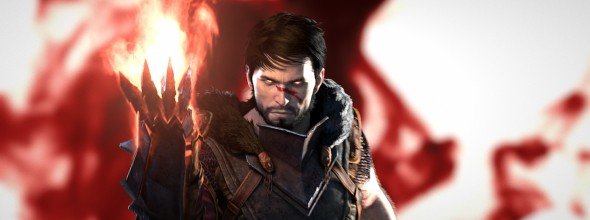
Mike Laidlaw: “There's still lots of opportunity to meet and talk to your characters and things like that. I want to play through the most important moments in this one character's life. That gives us a nice filter to hold each event and plot up against. 'Is this significant? Does this advance the themes of the game in some way?'”
Matt Goldman nails down the issue: “It's not like one little level: 'here's where he punched a guy in the face.' It's: 'this is his escape from his blightravaged home town'. The entire escape and the emotion, the side stuff around that event, not just the actual running. I guess the danger of focusing down on key moments is that you might think that we're focusing down super-tightly, and that's actually not the case.”
Mike Laidlaw again: “The framed narrative only limits choice if the narrators say 'the Champion was a man who decided the following things...' Instead what we're doing is have the narrators come in, and even though they lived in the future and they know the kind of things the Champion decided, it doesn't mean that they have to lock that down until the player has made those decisions. They're the perfect reaction, like our epilogues in Origins. What we've done is to move that to a pair of narrators who know the future, but as you make your decisions they then talk about the significance of them.” He smiles, slightly breathless from the quickfire explanation. “I still wanted to keep that element of RPG, that sense of exploration, progression, sidequests, looting, all that stuff is key, and losing that would be a shame. To me, this is really exciting because we can get even less linear, and less predetermined.”
But what's up with this world, why does it need changing? Origins saw the end of the largest blight in living memory, so what could possibly be wrong now? We're told there's a revolutionary war brewing, but BioWare are keeping their cards close to their chest at present.
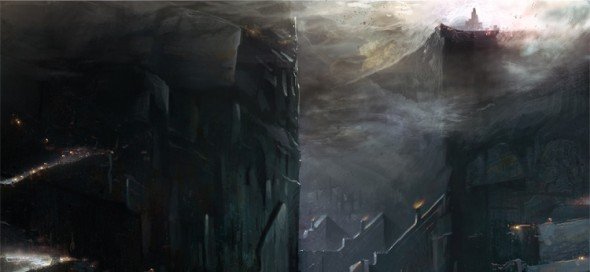
The continent of Thedas, where Dragon Age is set, is gigantic. All the action of Origins took place in Ferelden's southwest corner. Now we're moving up to the Free Marches. Mike Darreth: “the Free Marches are a loose collection of city states... it's more of a melting pot, a little more frontiers-y. You get more different cultures coming together, so it's more plausible to have you, over the course of a decade, moving from a refugee to a position of power and wealth.”
Geography test
The year spent brainstorming Dragon Age's universe into existence meant the groundwork was already laid for Dragon Age 2. As Mike Darreth put it: “the setting was established, so we didn't have to spend all this time deciding how magic worked, or what the countries looked like. We know what the Free Marches are, we know what the Fade is. All this stuff is already there, so that lets you start from an established setting and more quickly get to a final story.”
I tested this claim, jabbing at points on a six-foot map of the continent hung from the office wall and demanding answers. “That was where the first blight was. That's the town Leliana was from. That's the sea. That's my nose.”
Mike passed the test.
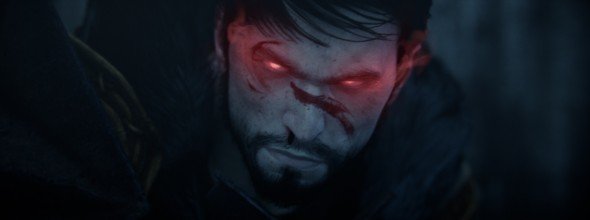
A new setting yields new scope: as art director on the series, Matt Goldman makes regular reference to a new, 'hotrodded' art style. “Marketing told me to say that,” he sighs.
Actually it's a doddle to see the change between Origins' muddy, bleary visuals and Dragon Age 2's stark, highcontrast lines. Clearly the artistic blandness of the first game still rankles for Goldman.
“Damn cheese-wheels,” he semimutters, referring to the ubiquitous hunks of Edam deployed around Origins' dungeons. Put in place solely to fill up space in sparse areas, they – and similar cliche-fantasy ephemera – distracted from the game's overall motif, softening the point of swordblades with down-home pointlessness. Matt snaps back from his frustrated reverie and explains: “The props are to help give context for what the area is, but overall I'd say Dragon Age 2 is a lot more minimalist looking. The intent is to create a strong personality without getting in your face and without distracting you with all these details that don't really do anything – they just screw up your path line and make shadows a lower resolution.”
The Free Marches provide a less stained canvas than Ferelden to carry off this strong personality. Like Italy in the 15th century, each sub-city of the region is set to have its own notable flavour. Mike Darreth's example is the Champion's adopted city of Kirkwall. “It's a former quarry, and also an old slave city. Because you've got that mix of cultures you can have an impact on the specific architectural elements.” Also, the team develop characters and races further, pulling them away from Origins' visual trio of human, short human, and skinny human.
Matt Goldman agrees: “It was pretty hard to tell elves and humans apart, so we've done a lot of work to make them different from one another. Our visual watchwords for DA2 are 'grim, bloody and sexy.' Morrigan somehow pulled it off in Origins, but because of the way the rigs and the animations were being shared, a lot of the females didn't exactly hit the right mark.”
Matt's background gives him a uniquely artistic perspective: “we've stripped off what's extraneous and as a result made the environments and characters sharper. The environment is basically – in terms of a band – the bassline. You have to lay down a nice thick bassline to set the mood: it's the backbone of the picture-making, story telling. But if it's too detailed then you get this disrupting camouflage problem where you can't tell what's going on. So by stripping away things and looking for opportunities to create some more dramatic silhouettes, you can focus attention on the character.”
Real life
Dragon Age: Origins' characters were its masterstroke, surrounding the mute player with genuine wit and sparkle. This pillar remains the very core of all of the team's discussions, as Mike Darreth confirms. “It's very important that the followers be characters, people, in and of themselves. With their own motivations, their own goals.” Unlike Origins, where unused party members presumably sat around the campfire, twiddling their thumbs until you returned with tales of adventure, Dragon Age 2's brood of followers will get on with their own lives. Darreth again: “they have jobs beyond adventurer – which doesn't pay very well obviously. You'll meet them in their day-to-day lives.”
The ten-year timeframe makes possible monumental character growth – both visually and in terms of personality. “You've got a home, but so do your followers,” Mike says. “You'll interact with them more out in the world. Additionally, they're going to react more to the world around them when you're adventuring with them. So you might be in the deep roads, and a dwarven character might be able to spot something he recognises.”
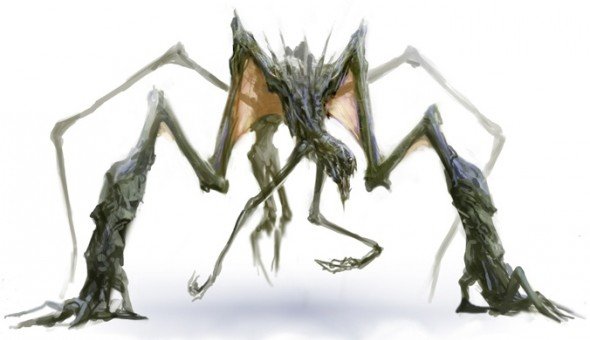
As characters react, so too does the environment. Save-game imports are confirmed: the near-infinite combination of endings from the first game will colour Dragon Age 2's future. Meanwhile, the choices you make throughout this game play out across the decade. “One of our principle things is that the story is all based on your choices. A large time-span means that if you make a choice early in the game, we can react to it in the middle of the game, rather than having to wait for, say, the epilogue to find out that Bann Teagan got married to Bella. I mean, that's cute and all, but you don't remember who Bella was.”
But, as with Origins, there's no morality system to pigeonhole your choices. “For me,” says Mike Darreth, “by us not applying our moral stance to you, the choices become more meaningful. We're not telling you this is good or evil – ultimately in the real world, no one thinks they're evil, no one thinks they're good. Everyone thinks they're doing things for a justifiable reason.” My justifiable reasons are usually that I'm an awesome mega-hero and anyone who says otherwise can shut the hell up: trust BioWare to accommodate me in this endeavour.
The team consider the idea of goodness in Dragon Age's bleak world: “You know you eventually become the Champion: how you got there doesn't have to be pretty. The big thing is to create scenarios that the game can then recognise going forward. If I save the man, I want to meet that man later. If I save the town, I want someone from the town to come thank me.” Matt Goldman steps in. “Or you can be EVIL, and dynamically grow a moustache for twirling.”
There's no path of non-violence, though. Saving every kitten on the continent won't save you from having to face Dragon Age's infamously tough battles. The PC got the far superior version of Dragon Age: Origins' combat engine: pausable and easily controlled, it's returning in much the same shape for the sequel. The party size is still set at four – forcing the player to make “meaningful tactical choices” according to Mike Darreth – and Origins' toolkit of hotbars and selectable party members is all present and correct.
Twhpp!
Watch it in motion, however, and it's a notable shift in gear. Get to play it – as I did – and it feels a much more lethal experience. Attacks are sharper in every way, landing with none of the usual stylised RPG combat dance: 'you swing then I'll swing.'
Mike Laidlaw is ecstatic that the feeling of speed is noticeable. “In Origins, if you wanted to do a critical shot, your character would draw, line it up, and then fire. Why couldn't my character just have a bow out, have an arrow knocked, and when I press that ability -twhpp!-. Then they have to shake it off and take a minute to draw. It's still got the same feel, but what I'm doing has impact the moment I press '3'. That's the thing we wanted to get rid of – that feel of lag.”
Animations look smooth and feel taut. Transitioning between a shield bash and a follow-up stab no longer requires polite shuffling: Hawk lunges forward like his foe's stomach is full of treasure, ripping his belly open as he languishes on the floor. I take control of companion Bethany and lob a fireball at the disembowelled Darkspawn's friends. It smacks home with a 'ba-woosh!' unexpected from such a basic spell.
Origins' magic was a pleasure; weighty and powerful there, it's been buffed further here, maelstroms of psychic energy tearing Darkspawn in half. Bethany fires off an attack at an onrushing ogre, and a seven-foot fist materialises in the mountain air. Opening quickly, it clutches the stricken creature, cradling him for a moment before clenching, squashing the lifeforce from his tubby form. There's a sickening crack as his massive bones break, before his flesh flickers in the air and he disappears, removed from existence by mystical energies. Combat has got a crunch you didn't feel in Dragon Age: Origins.
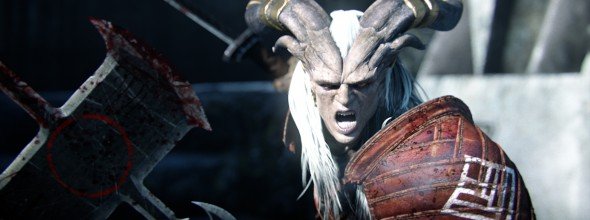
As it should: Bethany's spells have been levelled up. “You pick fireball as a spell and to start with maybe all it does is damage”, explains Mike Darreth. “Then, rather than spending a point to get a new spell, you might spend some of your points so it sets light to enemies, so there's damage over time. You're able to take your favourite spells and deepen them.”
This tech-tree-like system also applies to non-magic abilities, and is intended to buff Origins' weakest class, the rogue. Darreth describes the issue: “The problem we had in Origins was that the rogue is just a warrior that wears crappy armour. In Dragon Age 2, he feels more mobile, so he's more about getting in close, doing damage quickly, and getting away.”
As a pure killing machine, the rogue will stay handy for die-hard roleplayers, the kind who didn't flinch at Origins' challenging 'Normal' mode. Mike Laidlaw is aware of the complaints directed at the first game's difficulty level, but isn't aiming to make the experience notably easier for us.
“What I want to do is pull Normal down a bit, and keep Hard nice and ballsy, but we don't want to make it that that's the only way, because there are a lot of hardcore gamers who want to feel like, “I gotta roll that crit!”
I was caught off-guard by Dragon Age 2. PC Gamer's glowing review of the first game in the series stands, but the speed and fluidity with which the team have addressed Dragon Age: Origins' flaws is astounding. Asking players to fill in the gaps in an preexisting story is a daring narrative manoeuvre, but with exemplary writing, a deep tactical combat engine, and a world well-worn from a good few years of habitation, BioWare's game is in a perfect position to soar.

